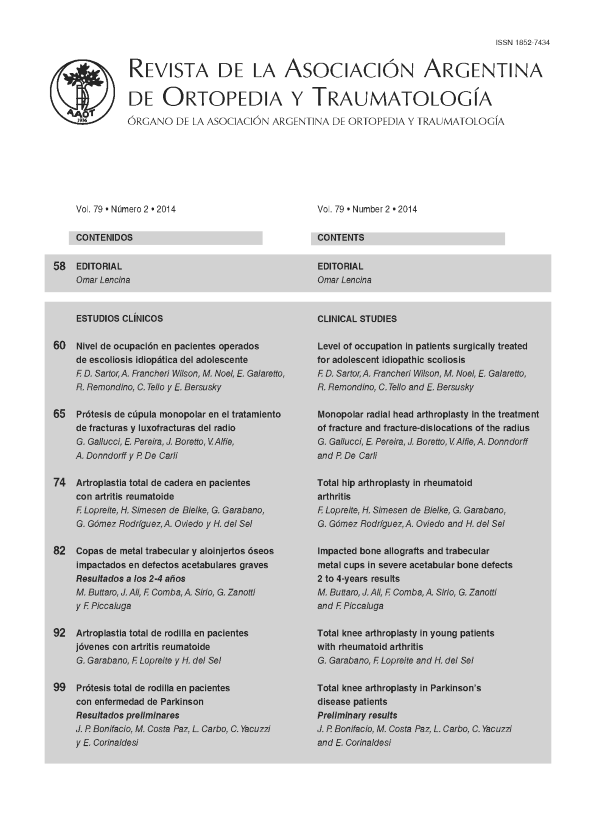Copas de metal trabecular y aloinjertos óseos impactados en defectos acetabulares graves. Resultados a los 2-4 años. [Impacted bone allografts and trabecular metal cups in severe acetabular bone defects: 2 to 4-year results.]
Contenido principal del artículo
Resumen
Descargas
Métricas
Detalles del artículo

Esta obra está bajo licencia internacional Creative Commons Reconocimiento-NoComercial-CompartirIgual 4.0.
La aceptación del manuscrito por parte de la revista implica la no presentación simultánea a otras revistas u órganos editoriales. La RAAOT se encuentra bajo la licencia Creative Commons 4.0. Atribución-NoComercial-CompartirIgual (http://creativecommons.org/licenses/by-nc-sa/4.0/deed.es). Se puede compartir, copiar, distribuir, alterar, transformar, generar una obra derivada, ejecutar y comunicar públicamente la obra, siempre que: a) se cite la autoría y la fuente original de su publicación (revista, editorial y URL de la obra); b) no se usen para fines comerciales; c) se mantengan los mismos términos de la licencia.
En caso de que el manuscrito sea aprobado para su próxima publicación, los autores conservan los derechos de autor y cederán a la revista los derechos de la publicación, edición, reproducción, distribución, exhibición y comunicación a nivel nacional e internacional en las diferentes bases de datos, repositorios y portales.
Se deja constancia que el referido artículo es inédito y que no está en espera de impresión en alguna otra publicación nacional o extranjera.
Por la presente, acepta/n las modificaciones que sean necesarias, sugeridas en la revisión por los pares (referato), para adaptar el trabajo al estilo y modalidad de publicación de la Revista.
Citas
A 6-year follow-up evaluation. J Arthroplasty 1994;9:33.
2. D’Antonio JA, Capello WN, Borden LS. Classification and management of acetabular abnormalities in total hip arthroplasty.
Clin Orthop Relat Res 1989;243:126-34.
3. Duffy GP, O´Connor MI, Brodersen MP. Fatigue failure of the GAP ring. J Arthroplasty 2007;22:711-4.
4. Buttaro M, Nunez L, Lopez Ovenza J, Comba F, Piccaluga F. Falla mecánica precoz de un anillo de reconstrucción acetabular
tipo Kerboull. Rev Asoc Argent Ortop Traumatol 2008;73:285-9.
5. Buttaro M, Munoz de la Rosa D, Comba F, Piccaluga F. High failure rate with the Gap II ring and impacted allograft bone in
severe acetabular defects. Clin Orthop Relat Res 2012;470(11):3148-55.
6. Bobyn JD, Stackpool GJ, Hacking SA, Tanzer M, Krygier JJ. Characteristics of bone ingrowth and interface mechanics of a
new porous tantalum biomaterial. J Bone Joint Surg Br 1999;81(5):907-14.
7. Sporer SM, Paprosky WG. The use of a trabecular metal acetabular component and trabecular metal augment for severe
acetabular defects. J Arthroplasty 2006;21(Suppl 2):83.
8. Van Kleunen JP, Lee GC, Lementowski PW, Nelson CL, Garino JP. Acetabular revisions using trabecular metal cups and
augments. J Arthroplasty 2009;24(Suppl):64-8.
9. Ballester Alfaro JJ, Sueiro Fernandez J. Trabecular metal buttress augment and the trabecular metal cup-cage construct in
revision hip arthroplasty for severe acetabular bone loss and pelvic discontinuity. Hip Int 2010;27(Suppl. 7):119-27.
10. Skytta ET, Eskelinen A, Paavolainen PO, Remes VM. Early results of 827 trabecular metal revision shells in acetabular revision.
J Arthroplasty 2011;26(3):342-5.
11. Davies JH, Laflamme GY, Delisle J, Fernandes J. Trabecular metal used for major bone loss in acetabular hip revision.
J Arthroplasty 2011;26(8):1245-50.
12. Sternheim A, Backstein D, Kuzyk PR, Goshua G, Berkovich Y, Safir O, et al. Porous metal revision shells for management of
contained acetabular bone defects at a mean follow-up of six years: a comparison between up to 50% bleeding host bone contact
and more than 50% contact. J Bone Joint Surg Br 2012;94(2):158-62.
13. Merle d’Aubigné R. Cotation chiffreé de la fonction de la hanche. Rev Chir Orthop Reparatrice Appar Moteur 1970;56:481-6.
14. Nunez L, Buttaro M, Morandi A, Pusso R, Piccaluga F. The value of intraoperative frozen section analysis in revision hip
surgery. Acta Orthop 2007;78:226-30.
15. Buttaro M, Comba F, Piccaluga F. Vancomycin-supplemented cancellous bone allografts in hip revision surgery. Clin Orthop
Relat Res 2007;461:74-80.
16. Slooff TJ, Schimmel JW, Buma P. Cemented fixation with bone grafts. Orthop Clin North Am 1993;24:667-77.
17. Böhm P, Banzhaf S. Acetabular revision with allograft bone. Acta Orthop Scand 1999;70(3):240-9.
18. Morsi E, Garbuz D, Gross AE. Revision total hip arthroplasty with shelf bulk allografts. J Arthroplasty 1996;11:86-90.
Año 79 • Número 2 • 2014 Copas de metal trabecular y aloinjertos óseos impactados en defectos acetabulares graves 91
19. DeLee JG, Charnley J. Radiological demarcation of cemented sockets in total hip replacement. Clin Orthop 1976;121:20-32.
20. Kaplan E, Meier P. Nonparametric estimation from incomplete observations. J Am Stat Assoc 1958;53:457-81.
21. Dearborn JT, Harris WH. Acetabular revision arthroplasty using so-called jumbo cementless components: an average 7-year
follow-up study. J Arthroplasty 2000;15:8-15.
22. Buttaro MA, Comba F, Pusso R, Piccaluga F. Acetabular revision with metal mesh, impaction bone grafting, and a cemented
cup. Clin Orthop Relat Res 2008;466(10):2482-90.
23. Bobyn JD, Pilliar RM, Cameron HU, Weatherly GC, Kent GM. The effect of porous surface configuration on the tensile
strength of fixation of implants by bone ingrowth. Clin Orthop 1980;149:291-8.
24. van Haaren EH, Heyligers IC, Alexander FG, Wuisman PI. High rate of failure of impaction grafting in large acetabular
defects. J Bone Joint Surg Br 2007;89:296-300.
25. Parratte S, Argenson JN, Flecher X, Aubaniac JM. Acetabular revision for aseptic loosening in total hip arthroplasty using
cementless cup and impacted morselized allograft Rev Chir Orthop Reparatrice Appar Mot 2007;93(3):255-63.
26. Rudelli S, Honda E, Viriato SP, Libano G, Leite LF. Acetabular revision with bone graft and cementless cup. J Arthroplasty
2009;24(3):432-43.
27. Kerboull M, Hamadouche M, Kerboull L. The Kerboull acetabular reinforcement device in major acetabular reconstructions.
Clin Orthop Relat Res 2000;378:155-68.
28. Udomkiat P, Dorr LD, Won YY, Longjohn D, Wan Z. Technical factors for success with metal ring acetabular reconstruction.
J Arthroplasty 2001;16:961-9.
29. Lunn JV, Kearns SS, Quinlan W, Murray P, O’Byrne J. Impaction allografting and the Kerboull acetabular reinforcement
device 35 hips followed for 3-7 years. Acta Orthop 2005;76:296-302.
30. Sembrano JN, Cheng EY. Acetabular cage survival and analysis of factors related to failure. Clin Orthop Relat Res
2008;466:1657-65.

